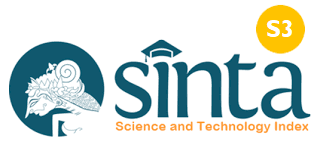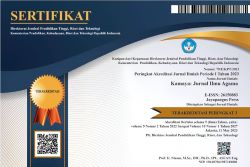Pemujaan Dewa-Dewa Lokal Dalam Pelaksanaan Saṃskāra Di Desa Pedawa Buleleng Bali
DOI:
https://doi.org/10.37329/kamaya.v4i3.1437Keywords:
Local Deity Worship, Saṃskāra, Pedawa VillageAbstract
The worship of local gods in the implementation of Saṃskāra in the Pedawa Village community is seen in the Sesapa spoken by Balian Desa in the implementation of the ritual. Not only local gods but worship of places and temples in Pedawa Village is also carried out. This study questions the worship of local gods that was carried out during the implementation of Saṃskāra in Pedawa Village. The method used in this research is descriptive qualitative. Data was collected by using interview and direct observation techniques. The results of this study show that the worship of local gods in the implementation of Saṃskāra in Pedawa Village can be divided into 4, namely (1) worship that is specifically shown to local gods, namely worship of gods who are believed by the Pedawa people to provide salvation as Ida Pengkan Prataksu , Ida Gede Kemulan, Rai Ida. (b) special worship for places in Pedawa Village such as Gunung Sari Pedawa, In Kamulan Bingin, Telaga Waja Pengampelan and other places in Pedawa Village (c) worship of holy places in Duurin Capah, namely worship of temples in the Tamblingan and Buyan Areas or known as Dalem Tamblingan Village Chess such as Ulun Danu Tamblingan Temple, Dalem Naga Loka, Sang Hyang Kangin, Dangin Capah taler ring Steaming. (d) worship of sacred places in Segara, namely the worship of the Labuan Aji Temple which is believed by the Duwuran Capah community to be a very important temple on the coast of the North Coast of Bali.
References
Donder. I K. (2006). Brahmavidya: teologi kasih semesta & kritik terhadap epistemologi teologi, klaim kebenaran, program misi, komparasi teologi, dan konversi. Paramitha : Surabaya.
Febriani, A., Dkk.(2020).Yos Sebagai Pengintegrasian Masyarakat Desa Pedawa. Humanis: Journal of Arts and Humanities Vol 24.3 Agustus 2020: 297-305.
Geriya. I.W. (1991). Peranan Agama Hindu dalam Transformasi Budaya. Denpasar : Institut Hindu Dharma.
Hooykas, C.(1951). Penyedar Sastra. Jakarta: J.B.Wolters.
Koran Bali Express Jawa Post Group Terbitan 26 Maret 2021
Lanus, S. (2014). Puja Tri Sandhya: Indian Mantras Recomposed and Standardised in Bali. Oxford University Press and The Oxford Centre for Hindu Studies. USA.
Mayuko, H. (2015). Bentuk Hormat Dialek Bahasa Bali Aga dalam Konteks Agama. Jurnal Masyarakat Linguistik Indonesia ISSN : 0215-4846. Jakarta.
Moleong, L.J. (2013). Metodologi Penelitian Kualitatif. Bandung: PT Remaja Rosdakarya.
Pudja, G. (2005). Bhagawad Gita (Pancama Veda). Surabaya: Paramita.
Suasthi, I. G. A., & Suadnyana, I. B. P. E. (2020). Membangun Karakter “Genius” Anak Tetap Belajar Dari Rumah Selama Pandemi Covid-19 Pada Sekolah Suta Dharma Ubud Gianyar. Cetta: Jurnal Ilmu Pendidikan, 3(3), 431-452.
Sukrata, I W. (1995). Tinjauan Upacara Ngangkid Sebagai Pelaksanaan Pitra Yadnya di Desa Adat Pedawa Kecamatan Banjar Kabupaten Buleleng. Singaraja. Sekolah Tinggi Keguruan Dan Ilmu Pendidikan.
Suwatno. E. (2004). Bentuk dan Isi Mantra. Jurnal Humaniora Volume 16, No.3, Oktober 2004 : 321-331.
Titib, I M. (1996). Veda Sabda Suci Pedoman Praktis Kehidupan. Surabaya: Paramita.
Titib, I M. (2009). Tri Sandhya Sembahyang dan Berdoa. Surabaya: Paramita
Titib. I M. (2003). Teologi dan Simbol-Simbol dalam Agama Hindu. Surabaya : Paramitha.
Titib. I M. (2005). Kamus Istilah Agama Hindu. Denpasar: Kantor Wilayah Departemen Agama Provinsi Bali
Downloads
Published
How to Cite
Issue
Section
License
An author who publishes in the Kamaya : Jurnal Ilmu Agama agrees to the following terms:
- Author retains the copyright and grants the journal the right of first publication of the work simultaneously licensed under the Creative Commons Attribution-ShareAlike 4.0 License that allows others to share the work with an acknowledgement of the work's authorship and initial publication in this journal
- Author is able to enter into separate, additional contractual arrangements for the non-exclusive distribution of the journal's published version of the work (e.g., post it to an institutional repository or publish it in a book) with the acknowledgement of its initial publication in this journal.
- Author is permitted and encouraged to post his/her work online (e.g., in institutional repositories or on their website) prior to and during the submission process, as it can lead to productive exchanges, as well as earlier and greater citation of the published work (See The Effect of Open Access).
Read more about the Creative Commons Attribution-ShareAlike 4.0 Licence here: https://creativecommons.org/licenses/by-sa/4.0/.





